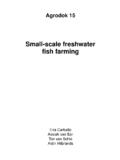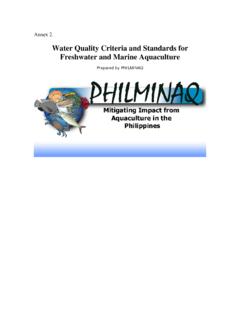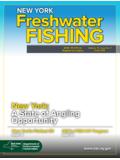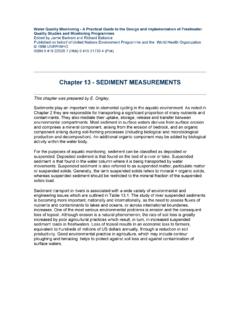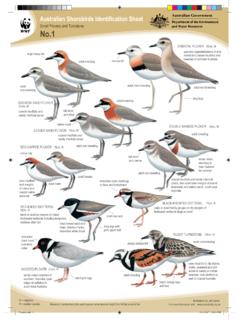Transcription of Farming freshwater prawns - Food and Agriculture ...
1 Farming freshwater prawnsA manual for the culture of the giant riverprawn (Macrobrachium rosenbergii)ISSN 0429-9345 FAOFISHERIESTECHNICALPAPER428byMichael B. NewMarlow, United KingdomFOOD AND Agriculture ORGANIZATION OF THE UNITED NATIONSRome, 2002 Farming freshwater prawnsA manual for the culture of the giant riverprawn (Macrobrachium rosenbergii)FAOFISHERIESTECHNICALPAPER42 8 ISBN 92-5-104811-8 FAO 2002 The designations employed and the presentation of material in thisinformation product do not imply the expression of any opinionwhatsoever on the part of the Food and Agriculture Organizationof the United Nations concerning the legal status of any country,territory, city or area or of its authorities, or concerning thedelimitation of its frontiers or rights reserved.
2 Reproduction and dissemination of material in thisinformation product for educational or other non-commercial purposes areauthorized without any prior written permission from the copyright holdersprovided the source is fully acknowledged. Reproduction of material in thisinformation product for resale or other commercial purposes is prohibited withoutwritten permission of the copyright holders. Applications for such permissionshould be addressed to the Chief, Publishing Management Service, InformationDivision, FAO, Viale delle Terme di Caracalla, 00100 Rome, Italy or by e-mailto mention of specific companies, their products or brand names does notimply any endorsement by the Food and Agriculture Organization of theUnited rights reserved.
3 Reproduction and dissemination of material in this information product for educational or other non-com-mercial purposes are authorized without any prior written permission from the copyright holders provided the source is fullyacknowledged. Reproduction of material in this information product for resale or other commercial purposes is prohibited with-out written permission of the copyright holders. Applications for such permission should be addressed to the Chief, PublishingManagement Service, Information Division, FAO, Viale delle Terme di Caracalla, 00100 Rome, Italy or by e-mail to FAO 2002 The designations employed and the presentation of material in this infor-mation product do not imply the expression of any opinion whatsoever onthe part of the Food and Agriculture Organization of the United Nationsconcerning the legal status of any country, territory.
4 City or area or of itsauthorities, or concerning the delimitation of its frontiers or OF THIS DOCUMENT A PREVIOUS MANUAL ON THIS TOPIC was prepared for FAO in 1982 and revised in 1985 but theEnglish edition is now out-of-print. Research has generated considerable benefits on this subjectand substantial advances in technology have occurred since the original manual was facts, combined with a revival in interest in expanding the Farming of freshwater prawns , havecreated the need for a new technical document has therefore been prepared to provide up-to-date and practical information onfreshwater prawn Farming .
5 Its emphasis is on techniques for cultivating the major farmed species,namely the giant river prawn (Macrobrachium rosenbergii). The manual also contains information ofrelevance to the Farming of other Macrobrachiumspecies and to the enhancement of freshwaterprawn document was prepared under contract for the Inland Water Resources and AquacultureService, FAO Fishery Resources Division, by one of the authors of the original FAO manual, MichaelB. New. It is a synthesis of the personal experience of the author and of his many internationalfriends and colleagues working in this field, who are gratefully acknowledged within the principal targeted audience includes trainers, extension agents, farmers, and students.
6 It isalso hoped that the manual will provide background information and reference sources for thoseembarking on research in this mention of specific companies, their products or brand names does not imply any endorsement by the Food andAgriculture Organization of the United ORIGINAL MANUALon freshwater prawn Farming was published in English, Frenchand Spanish by FAO and translated by others into Farsi, Hindi, and Vietnamese. In thetwo decades since that manual was written, many technical and practical advances havebeen made in the rearing of freshwater prawns .
7 Greater farmed production, developingglobal markets, and the need to ensure that each form of aquaculture is sustainable, haveled to an increased interest in the Farming of freshwater prawns . A new manual has there-fore been prepared, which will be issued in each of the FAO official manual provides information on the Farming of Macrobrachium of the techniques described are also applicable to other species of freshwater prawnsthat are being cultured. The manual is not a scientific text but is intended to be a practi-cal guide to in-hatchery and on-farm management.
8 The target audience is therefore prin-cipally farmers and extension workers. However, it is also hoped that, like the previousmanual on this topic, it will be useful for lecturers and students alike in universities andother institutes that provide training in a preliminary section on the biology of freshwater prawns , the manual coverssite selection for hatcheries, nurseries and grow-out facilities, and the management of thebroodstock, hatchery, nursery and grow-out phases of rearing. Harvesting and post-harvesthandling are also covered and there are some notes on marketing freshwater prawns .
9 Thereference and bibliography section is generally restricted to a list of relevant reviews, aswell as other (mainly FAO) manuals on general aquaculture themes, such as water and soilmanagement, topography, pond construction and simple economics. Every attempt hasbeen made to illustrate the management principles described in this manual by photo-graphs and drawings. The manual contains many annexes on specific topics, such as theproduction of larval feeds, size variation and stock estimation. The final annex is a glos-sary.
10 This lists not only terms used in the manual itself but also terms which the readersmay find in other documents that they may words:Macrobrachium, broodstock management, crustacean culture, freshwa-ter prawns , hatchery operation, grow-out procedures, post-harvest handling and market-ing, site selectionABSTRACT iiiprefaceAN EARLIER FAO MANUALon freshwater prawn culture was written by the former Co-Managers of the UNDP/FAO Programme for the Expansion of freshwater prawn Farmingin Thailand, Michael New and Somsak Singholka, which was based substantially on theirpersonal experience.










